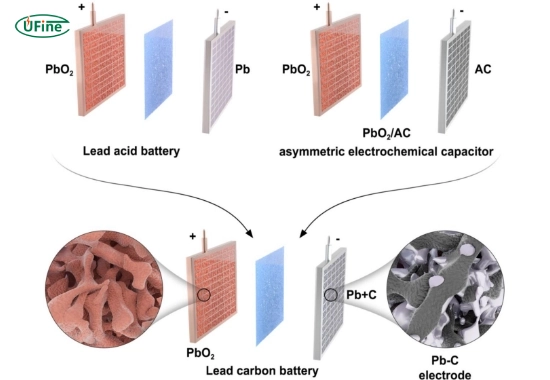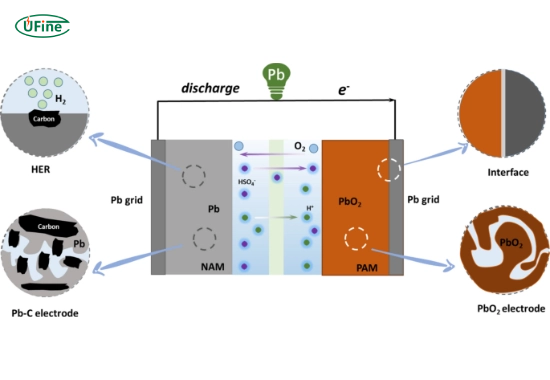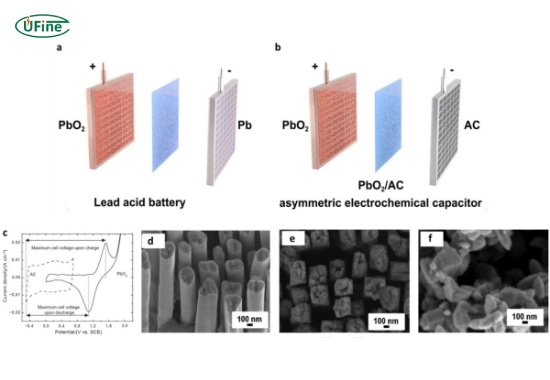
- Part 1. What is a lead carbon battery?
- Part 2. How does a lead carbon battery work?
- Part 3. What are the advantages of lead carbon batteries?
- Part 4. Where are lead carbon batteries used?
- Part 5. How do lead carbon batteries compare to other battery technologies?
- Part 6. How does the technology behind lead carbon batteries improve energy storage efficiency?
- Part 7. What challenges do lead carbon batteries face?
- Part 8. How do you maintain a lead carbon battery?
- Part 9. Are there environmental considerations with lead carbon batteries?
- Part 10. FAQs
In the ever-evolving world of energy storage, the lead carbon battery stands out as a revolutionary solution that combines the reliability of traditional lead-acid batteries with cutting-edge carbon technology. This article will explore lead carbon batteries’ unique features, benefits, and applications, shedding light on their potential to transform energy storage across various sectors.
Part 1. What is a lead carbon battery?
A lead carbon battery is a type of rechargeable battery that integrates carbon materials into the conventional lead-acid battery design. This hybrid approach enhances performance, longevity, and efficiency. Incorporating carbon improves the battery’s conductivity and charge acceptance, making it more suitable for high-demand applications.
Key Components
- Lead Plates: The primary electrodes that facilitate electrochemical reactions.
- Carbon Additives: These enhance conductivity and overall performance.
- Electrolyte: Typically sulfuric acid, which facilitates ion movement between the electrodes.
Part 2. How does a lead carbon battery work?
Lead carbon batteries operate on the same fundamental principles as conventional lead-acid batteries but are more efficient because they incorporate carbon materials.
The Electrochemical Process
- Discharge Phase: During discharge, lead dioxide (PbO2) at the positive plate reacts with hydrogen ions from the electrolyte to produce lead sulfate (PbSO4) and water.
- Charge Phase: When charging, lead sulfate is converted back to lead dioxide and sponge lead (Pb) at the respective electrodes.
Carbon helps maintain a stable structure during these reactions, reducing sulfation—a common issue in traditional lead-acid batteries that can shorten lifespan.
Part 3. What are the advantages of lead carbon batteries?
Lead carbon batteries offer several compelling benefits that make them an attractive option for energy storage:
- Enhanced Cycle Life: They can endure more charge-discharge cycles than standard lead-acid batteries, often exceeding 1,500 cycles under optimal conditions.
- Faster Charging: The improved conductivity allows quicker charging times, often within 2 hours for full recharge in many applications.
- Higher Efficiency: With less energy loss during charging and discharging, these batteries have an efficiency rate of around 90%, compared to approximately 80% for traditional lead-acid batteries.
- Cost-Effectiveness: While initial costs may be higher than traditional batteries, their longer lifespan and reduced maintenance needs can result in lower total ownership costs over time.
Part 4. Where are lead carbon batteries used?
The versatility of lead carbon batteries allows them to be employed in various applications:
- Renewable Energy Systems: They are particularly well-suited for solar and wind energy storage, where rapid charging and discharging are essential.
- Electric Vehicles (EVs): Their ability to provide high power output makes them suitable for specific EV applications.
- Uninterruptible Power Supplies (UPS): Lead carbon batteries can ensure reliable power supply during outages.
- Telecommunications: They support backup power systems in telecom infrastructure.
Can I use a lead carbon battery in an electric vehicle?
You must consider specific requirements such as weight and energy density when using a lead-carbon battery in an electric vehicle. While they offer advantages like fast charging and durability, they may provide a different range or efficiency than lithium-ion batteries in modern EVs.
Part 5. How do lead carbon batteries compare to other battery technologies?
When comparing lead carbon batteries to other popular energy storage solutions like lithium-ion and traditional lead-acid batteries, several factors come into play:
Lead carbon batteries typically have a longer cycle life than traditional lead-acid options but fall short compared to lithium-ion technology. For instance:
- Cycle Life: Lead carbon batteries can last up to 1,500 cycles; lithium-ion can exceed 3,000 cycles.
- Charging Time: Lead carbon batteries can recharge in about 2 hours, while lithium-ion batteries typically take about 1 hour for fast charging.
- Energy Density: Lead carbon has an energy density of around 30-50 Wh/kg, compared to lithium ions’ impressive range of 150-250 Wh/kg.
- Cost per Cycle: Lead carbon costs approximately $0.10, while lithium-ion can cost around $0.20-$0.30 per cycle due to higher initial costs but longer lifespans.
| Feature | Lead Carbon Batteries | Lithium-Ion Batteries | Traditional Lead-Acid Batteries |
|---|---|---|---|
| Cycle Life | Up to 1,500 cycles | Over 3,000 cycles | About 500 cycles |
| Charging Time | ~2 hours | ~1 hour | ~8 hours |
| Energy Density | 30-50 Wh/kg | 150-250 Wh/kg | 30-40 Wh/kg |
| Cost per Cycle | ~$0.10 | ~$0.20-$0.30 | ~$0.05 |
| Efficiency | ~90% | ~95% | ~80% |
Part 6. How does the technology behind lead carbon batteries improve energy storage efficiency?
The technology behind lead carbon batteries significantly enhances energy storage efficiency through several mechanisms:
- Improved Conductivity: Adding conductive carbon materials allows for better electron flow within the battery, reducing resistance during charging and discharging.
- Reduced Sulfation: Carbon helps mitigate sulfation—a common issue in traditional lead-acid systems—by providing a more stable structure during charge-discharge cycles. This leads to longer operational life and better performance over time.
- Higher Charge Acceptance: The unique design allows these batteries to accept higher charge rates without overheating or degrading quickly, making them ideal for applications that require rapid energy replenishment.
- Temperature Tolerance: Lead-carbon batteries generally perform better across a more comprehensive temperature range than traditional options, ensuring consistent performance even in challenging conditions.
Part 7. What challenges do lead carbon batteries face?
Despite their advantages, lead carbon batteries are not without challenges:
- Weight: They tend to be heavier than lithium-ion alternatives, which can be a drawback in mobile applications like electric vehicles.
- Energy Density: While improved over traditional lead-acid batteries, their energy density still lags behind lithium-ion technology.
- Market Awareness: Many consumers and industries need to be aware of the benefits of this technology compared to more established options.
Part 8. How do you maintain a lead carbon battery?
Proper maintenance is crucial for maximizing the lifespan and performance of lead carbon batteries:
- Regular Charging: Avoid deep discharges; keep them topped up whenever possible.
- Temperature Control: Store and operate within recommended temperature ranges to prevent damage.
- Periodic Testing: Regularly check voltage levels and overall health to identify potential issues early on.
Part 9. Are there environmental considerations with lead carbon batteries?
While lead carbon batteries are generally more environmentally friendly than traditional lead-acid options due to reduced sulfation and longer life cycles, they still pose some environmental concerns:
- Lead Toxicity: Lead is toxic; thus, proper recycling processes are essential to prevent contamination.
- Carbon Footprint: The production process still contributes to greenhouse gas emissions, albeit less than some alternatives.
Part 10. FAQs
-
What is the lifespan of a lead carbon battery?
The lifespan typically ranges from 3 to 5 years but can extend beyond this with proper care and maintenance. -
Are there specific applications where lead carbon batteries excel?
They excel in renewable energy systems like solar power storage due to their rapid charge capabilities and durability. -
How do I recycle a lead carbon battery?
Certified facilities should handle the recycling of hazardous materials like lead. -
What makes lead carbon batteries better than traditional lead-acid ones?
They offer longer cycle life (up to 1,500 cycles), faster charging times (around 2 hours), and improved efficiency (about 90%). -
What is the self-discharge rate of a lead-carbon battery?
Lead-carbon batteries typically have a low self-discharge rate of ≤3% per month, allowing them to retain their charge even when not in use for extended periods.
Related Tags:
More Articles

Battery Load Test: A Comprehensive Guide
Step-by-step battery load test guide for car, solar & industrial use. Learn how to load test a battery, interpret voltage charts, and avoid common mistakes.
The Comprehensive Guide to Battery Balancing and Battery Balancer
Discover how battery balancers improve lithium battery performance, lifespan, and safety. Learn types, functions, and tips to choose the right balancer.
What Is the Best Voltage for a Chainsaw Battery?
Compare 12V-80V chainsaw batteries for light pruning, medium firewood, and professional cutting. See best battery chainsaw with runtime charts and safety tips.
Lithium VS. Alkaline Batteries: A Comprehensive Comparison
Lithium batteries last 3–7× longer than alkaline and perform better in cold weather. Compare lifespan, cost, safety, and best uses to choose the right battery.
Comparing Lithium-Sulfur and Lithium-Ion Batteries: Which is Right for You?
Compare lithium-sulfur (Li-S) and lithium-ion batteries on energy, lifespan, cost, safety, and applications. Best choice for drones, EVs, and electronics.





